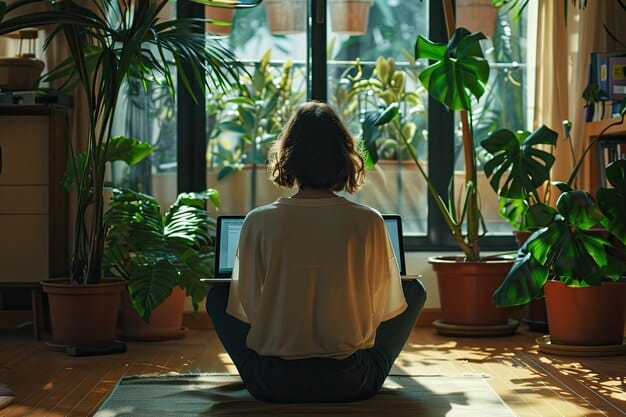Unlock Inner Peace: A Beginner’s Guide to Meditation Benefits

The Benefits of Meditation: A Comprehensive Guide for Beginners explores the profound physical, mental, and emotional advantages of incorporating meditation into daily life, offering practical steps for newcomers to start and maintain a fulfilling meditation practice.
Embark on a journey to discover the transformative power of inner peace. The Benefits of Meditation: A Comprehensive Guide for Beginners will illuminate how this ancient practice can revolutionize your mental, physical, and emotional well-being.
Understanding the Core of Meditation
Meditation, often perceived as a complex and esoteric practice, is fundamentally simple: training your mind to focus and redirect your thoughts. It’s about cultivating awareness of the present moment without judgment, paving the way for increased self-awareness and inner peace.
The Essence of Mindfulness
Mindfulness forms the cornerstone of many meditation practices. It involves paying attention to your thoughts, feelings, and bodily sensations without getting carried away by them. This present-moment awareness can significantly reduce stress and anxiety.
Different Styles of Meditation
From mindfulness meditation to guided visualizations, various techniques can suit individual preferences and needs. Each offers a unique approach to achieving mental clarity and emotional balance.
- Mindfulness Meditation: Involves focusing on the present moment, observing thoughts and sensations without judgment.
- Transcendental Meditation (TM): Utilizes a mantra to quiet the mind and promote deep relaxation.
- Guided Meditation: Follows a narrator’s guidance to visualize scenes or focus on specific themes.
- Loving-Kindness Meditation: Cultivates feelings of compassion and kindness toward oneself and others.
Exploring different styles allows you to find the method that resonates best with your personal journey toward mindfulness and well-being. There’s no one-size-fits-all approach; experimentation is key.
In essence, understanding the core of meditation is about recognizing its simplicity and adaptability. It’s a practice accessible to everyone, regardless of background or experience, offering a pathway to enhanced mental and emotional well-being.
The Physical Benefits of Regular Meditation
Beyond its mental and emotional advantages, regular meditation offers a wealth of physical benefits. From lowering blood pressure to improving sleep quality, the practice has a tangible impact on overall health.

Lowering Blood Pressure
Studies have shown that meditation can significantly reduce blood pressure, a major risk factor for heart disease. The practice promotes relaxation, which helps to dilate blood vessels and improve circulation.
Improving Sleep Quality
Meditation can be a powerful tool for combating insomnia and improving sleep quality. By quieting the mind and reducing stress, it creates the ideal conditions for restful sleep.
- Reduces stress hormones: Cortisol levels decrease, promoting relaxation.
- Quiets mental chatter: Prevents racing thoughts from disrupting sleep.
- Enhances relaxation response: Activates the parasympathetic nervous system, inducing calmness.
These physical benefits highlight the holistic impact of meditation, connecting the mind and body in a powerful way. By incorporating regular meditation into your routine, you can experience tangible improvements in your physical health and well-being.
In summary, the physical benefits of meditation are far-reaching and well-documented. By lowering blood pressure and improving sleep quality, meditation supports overall health and contributes to a more balanced and vibrant life.
Mental and Emotional Well-being Through Meditation
Meditation is a powerful tool for enhancing mental and emotional well-being. It provides a pathway to greater self-awareness, reduced stress, and improved emotional regulation.
Reducing Stress and Anxiety
One of the most well-known benefits of meditation is its ability to reduce stress and anxiety. By calming the mind and promoting relaxation, meditation can alleviate the symptoms of chronic stress and anxiety disorders.
Cultivating Emotional Resilience
Meditation can help you develop emotional resilience, the ability to bounce back from setbacks and challenges. By increasing self-awareness and emotional regulation, you can navigate difficult situations with greater ease and equanimity.
- Increases self-awareness: Helps you understand your emotional triggers and patterns.
- Enhances emotional regulation: Allows you to respond to emotions with greater control.
- Promotes acceptance: Fosters a non-judgmental attitude toward your thoughts and feelings.
Through consistent practice, meditation can transform your relationship with your emotions, enabling you to live with greater presence, compassion, and peace of mind.
Ultimately, meditation serves as a cornerstone for mental and emotional wellness, fostering a deeper understanding of oneself and promoting a more balanced and resilient approach to life’s challenges.
Starting Your Meditation Journey: A Step-by-Step Guide
Embarking on a meditation journey can seem daunting, but it doesn’t have to be. This step-by-step guide provides a simple, practical approach to starting and maintaining a fulfilling meditation practice.
Creating a Dedicated Space
Designating a quiet and comfortable space for meditation can enhance your practice. Choose a location where you can relax and focus without distractions.
Finding the Right Posture
Whether you prefer sitting on a cushion, chair, or lying down, finding a comfortable and supportive posture is essential. The key is to maintain alertness without straining your body.
- Sitting: Use a cushion or chair to support your spine and maintain an upright posture.
- Lying down: Ensure your body is relaxed and supported, avoiding positions that induce sleepiness.
- Walking: Practice mindful walking, focusing on the sensation of your feet making contact with the ground.
Once you’ve found your posture, take a few deep breaths and begin to focus on your breath, and allow your mind to quiet.
Starting your meditation journey is about taking small, consistent steps. By creating a dedicated space and finding the right posture, you can set the stage for a rewarding and transformative practice.
Incorporating Meditation into Your Daily Routine
The key to experiencing the long-term benefits of meditation is consistency. Integrating the practice into your daily routine ensures that it becomes a sustainable and integral part of your lifestyle.

Setting Realistic Goals
Begin with short meditation sessions, gradually increasing the duration as you become more comfortable. Setting realistic goals ensures that you stay motivated and avoid burnout.
Using Technology to Support Your Practice
Meditation apps and online resources can provide valuable guidance and support. Explore different options to find tools that resonate with your personal preferences and needs.
- Guided meditation apps: Offer a wide range of guided meditations and mindfulness exercises.
- Online meditation communities: Provide a platform for connecting with other practitioners and sharing experiences.
- Timer apps: Help you track your meditation sessions and stay focused.
Integrating meditation into your daily routine is about finding what works best for you. You don’t need to set aside hours; even a few minutes each day can make a profound difference in your mental and emotional well-being.
In summary, incorporating meditation into your daily routine is about making it a sustainable and enjoyable habit. By setting realistic goals and leveraging technology, you can weave meditation into the fabric of your life, reaping its benefits for years to come.
Overcoming Common Challenges in Meditation
Like any new practice, meditation can present its challenges. Understanding these obstacles and developing strategies to overcome them is essential for maintaining a consistent and rewarding practice.
Dealing with a Wandering Mind
It’s natural for your mind to wander during meditation. When this happens, gently redirect your attention back to your breath or chosen focus without judgment.
Managing Physical Discomfort
Physical discomfort can be a major obstacle to meditation. Adjust your posture, use props for support, and practice gentle stretching to alleviate tension.
- Experiment with different postures: Find a position that supports your body and minimizes discomfort.
- Use props for support: Cushions, blankets, and chairs can help you maintain a comfortable posture.
- Practice gentle stretching: Loosen tight muscles and improve circulation before meditating.
Every hurdle is an opportunity to deepen your practice and strengthen your commitment to well-being.
Addressing these challenges with patience and perseverance can lead to a more fulfilling experience. Remember, the goal is not to eliminate distractions, but to cultivate a non-judgmental awareness of them.
| Key Benefit | Brief Description |
|---|---|
| 🧘 Stress Reduction | Meditation helps lower cortisol levels, reducing stress and anxiety. |
| ❤️ Improved Heart Health | Regular meditation can lower blood pressure and improve circulation. |
| 😴 Better Sleep Quality | Meditation quiets the mind, promoting restful and uninterrupted sleep. |
| 🧠 Enhanced Focus | Meditation trains the mind to concentrate, improving focus and attention span. |
Frequently Asked Questions (FAQ)
▼
The best time to meditate varies from person to person. Many prefer meditating in the morning to set a calm tone for the day, while others find evening sessions helpful for relaxation before bed. Experiment to see what works best for you.
▼
As a beginner, start with shorter sessions of 5-10 minutes. Gradually increase the duration as you become more comfortable. Consistency is more important than length, so aim for regular, shorter sessions over occasional long ones.
▼
Clearing your mind completely isn’t the goal of meditation. Acknowledge the thoughts, and gently redirect your attention back to your breath or focus point. The practice is in the redirection, not the elimination of thoughts.
▼
No special equipment is required. Comfortable clothing is recommended, so you can relax without distractions. A quiet space and a cushion or chair may enhance your experience, but are not essential.
▼
Meditation is generally safe and beneficial. However, individuals with certain mental health conditions should consult a healthcare professional before starting a practice. It’s important to approach meditation with realistic expectations and gentle self-compassion.
Conclusion
As you begin your meditation journey, remember that consistency and patience are key. The benefits of meditation unfold gradually, transforming your mental, physical, and emotional well-being over time. Embrace the practice with an open mind and a gentle heart, and discover the profound peace that lies within.





